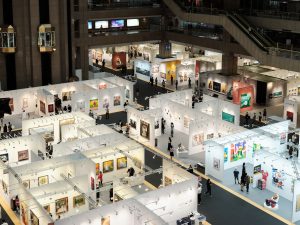
A view of the ART TAIPEI 2021 art fair. (photograph courtesy of ART TAIPEI)
By CHIEN, Yu-Ting
When art fairs think about rebranding, it is not only to enhance the brand value of the fair, but also to respond to the ever-changing art market and changes in the industrial structure that is keeping pace with the times.
Art fairs worldwide have experienced explosive growth and recovery after the COVID-19 pandemic. As international art fairs and exhibition alliances continue to expand their global footprint, including Art Basel, Frieze Art Fair, as well as groups such as The Art Assembly, which hosts Taipei Dangdai, use strategic layouts to attract a wide range of art enthusiasts and collectors from all over the world. In addition, in a fiercely competitive environment, the emergence of the younger generation of collectors, the rapid development of digital technology and the transformation of communities have given rise to new forms of artistic creation and enriched the purchasing channels for collectors and investors, prompting market demands to become increasingly diverse. The contemporary environment has brought challenges to experienced art fair brands. They urgently need to adopt diversified strategies and methods to cope with the ever-expanding and changing demands of the art market, and create unique positions for themselves in order to consolidate their position in the market.
Grasping the pulse of the trends through content transformation.

A view of Art Cologne. (photograph courtesy of Art Cologne)
The exhibit attributes and exhibit units are fundamental, core values of art fairs. Whether it is an established or an emerging art fair, they often collaborate with collectors or curators to become actively involved in fields of contemporary art in order to respond to the changes in market demands. For example, Art Cologne, which was first held in 1967, launched a program sponsoring young artists in the 1980s3, awarding the Art Cologne Prieze, and launched the emerging gallery area and experimental new media art exhibits4 .This transformation shifted the focus of the art fair from modern art to contemporary art, allowing the brand to move to the forefront of contemporary trends and establish a connection with the market.Similarly, ART TAIPEI has been evolving with the times and bouncing between different trends and fields, from fashion boutiques to the digital field, and actively creating a brand image that is keeping pace with the times. For example, in 2022, in the art market boom caused by blockchain technology, the "Crypto Art Zone" provided corresponding technical support and services, and at the same time, the event rode on the wave of the audio economy to present the podcast zone "ART TAIPEI Live Talk”. The fair also curated the "Fashion Art Cross-sector Special Exhibition" and the documentary photography exhibition of Magnum Photos. All these thematic exhibits year after year have allowed ART TAIPEI to keep developing new looks for itself and to maintain the buzz in its branding.

The ART TAIPEI 2021 x fashion cross-sector special exhibition, an exhibit combining fashion and art (photograph courtesy of ART TAIPEI)
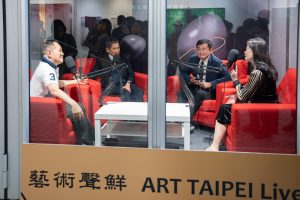
ART TAIPEI 2022 set up a booth to hold the ART TAIPEI Live talk podcast onsite. (photograph courtesy of ART TAIPEI)
Connecting regional resources to shape urban trajectories.

A view of Parades for FIAC. (photograph courtesy of Giovanni Sighele,CC BY 2.0)
Compared with the format of international art fairs that ‘pops by’ and then leaves, regional art fairs often collaborate with governments and cultural institutions to link up diverse activities and events with exhibitions to achieve the reshaping of brand positioning. For example, the FIAC, which will celebrate its 49th year in November of 2023, has been working with the Paris Municipal Government, the French Ministry of Culture and major art and cultural institutions. In 2006, the fair stretched its exhibition venue to free public places, which then evolved into Parades for FIAC6, and various forms of activities ranging from outdoor sculptures to performing arts, video and new media, poetry, dance and concerts. The fair also works in conjunction with the (Off)icielle Art Fair to present mostly local avant-garde works from France, and all of these have created an art carnival for Paris that can satisfy enthusiasts of different artistic tastes. ART TAIPEI has taken a similar approach through the “Art Museum Partnerships” to bring the many art museums in Taiwan together,to promote online and physical exhibitions, to put on events, and thus turn art fairs into a city-wide art event. Since 2016, ART TAIPEI has also successively collaborated with the Ministry of Education, the Ministry of Culture, and the Council of Indigenous Peoples to curate "Art Education Day", "MIT-Taiwan Young Artists Connection with the World" and "Indigenous People art special exhibition " in order to actively integrate resources from the government with those of the art and culture sector, and also to introduce training of talents as art guides, as well as programs to link up with educational courses. All of these can create a tightly integrated network involving the industry, government, academia, and art collection, with art fairs acting as the medium for conveying aesthetics and cultivating a population that appreciates art.

The ART TAIPEI art education day takes the treasure trove of art at the art fair and shares it with students of various ages. (photograph courtesy of ART TAIPEI)
Joining hands with international networks to rebuild brand resilience.
Regional art fairs usually collaborate with international media, commercial galleries and other organizations, and drive local market development based on their geographical location or regional market advantages. For example, the Korea International Art Fair (KIAF Seoul) used to set a country as the theme of the exhibition every year, so as to introduce the galleries and works from the theme country to the Korean art market8. In 2022, it joined hands with the international art fair brand Frieze to jointly establish the Kiaf Plus and Frieze Masters with the newly launched FRIEZE SEOUL exhibition, where the focus was on NFT, multimedia art and new galleries to provide audiences with the opportunities to explore the newly emerging creative artscape. In contrast, with relatively limited international resources, ART TAIPEI chose to call for establishing of the Asia Pacific Gallery Alliance (APAGA), gathering members of gallery associations from the five major regions in the Asia-Pacific to expand the regional scope of the event. In addition, ART TAIPEI has also joined the Gallery Climate Coalition (GCC) jointly established by London gallery owners and Frieze, and through the Taipei Art Economy Research Center attached to Taiwan Art Gallery Association, the organization conducts in-depth research on the dynamics of the international art market, and customizes academic forums for Taiwan every year. These forums cover a wide range of sectors, from finance, appraisal, corporate art acquisition to systematic archiving of information for the construction of art history in Taiwan, which can all help ART TAIPEI maintain its role in leading the Taiwanese art market in the ever-changing world.
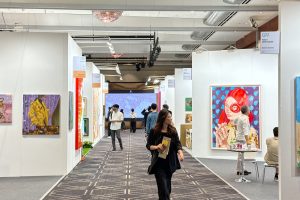
A view of the Kiaf Plus 2023 exhibition venue. (photograph courtesy of Viola Yao)
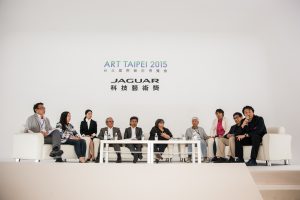
The first gathering of APAGA members at a ART TAIPEI 2015 forum (photograph courtesy of ART TAIPEI)
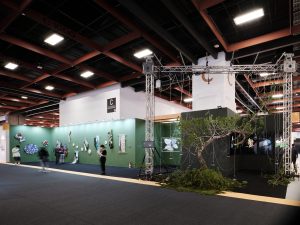
By joining the Gallery Climate Coalition, and setting up the Artificial, Evolution and Sustainable Future Special Exhibition,
ART TAIPEI hopes to strive towards becoming a green exhibition. (photograph courtesy of ART TAIPEI)
In fact, ART TAIPEI has been focused on the artistic experience and aesthetic education of urban culture in its brand redevelopment strategy, which is also consistent with regional art fairs such as the Armory Show in New York and Art Dubai, where the history and characteristics of the region are taken into account, and the art fairs are built into a place for the exchange of ideas and experiences, giving visitors an opportunity to observe the interactions between a city and the global art market during the ups and downs, which also reflect the diversity in regional art ecology. Even though the process of rebranding usually takes several years and can be affected by the strategic decisions of international art fairs, in its pursuit to become an global art sales platform, ART TAIPEI is embracing future possibilities, differentiating itself from other art fairs, and building a distinct brand image that characterizes an Asian art fair.
